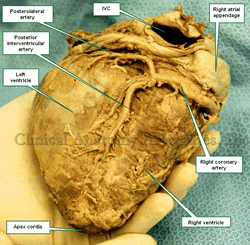|
UPDATED: The term [Crux Cordis] is Latin and means "the cross of the heart". It is an anatomical landmark used in angiography. It is formed by the crossing of the atrioventricular sulcus and the conjunction of the posterior interventricular sulcus and the interatrial sulcus. In the accompanying image the atrioventricular sulcus is colored blue, the posterior interventricular sulcus is red, and the interatrial sulcus is green. The right coronary artery, posterolateral artery, and the circumflex artery are found in the atrioventricular sulcus. The posterior interventricular artery (PDA) is found in the posterior interventricular sulcus. The AV node artery, which provides blood supply to the AV node (a component of the conduction system of the heart) usually arises from the PDA , the right coronary artery, or the posterolateral artery at the level of the crux cordis. |
|
| The interatrial sulcus (of Waterston) is curved and hugs the inferior vena cava. |
|
| MTD Main Page | Subscribe to MTD |
